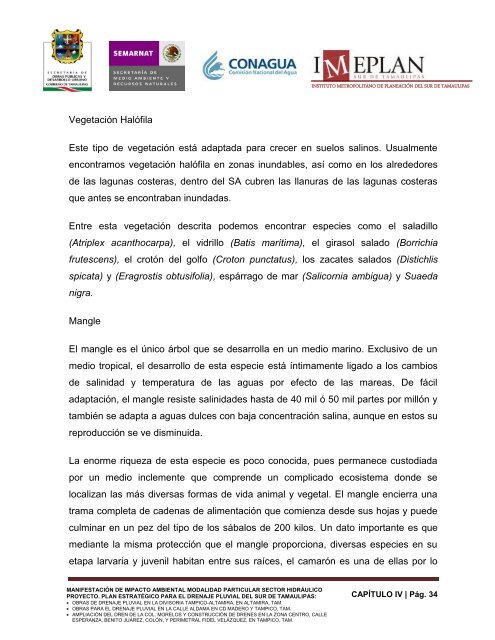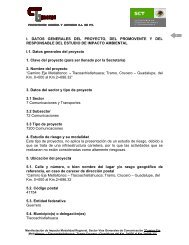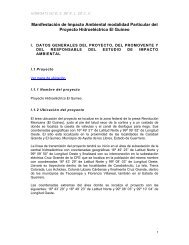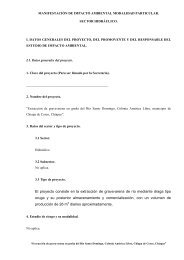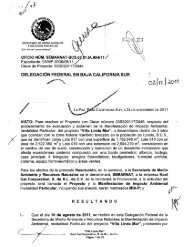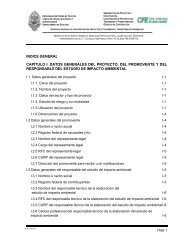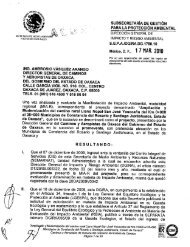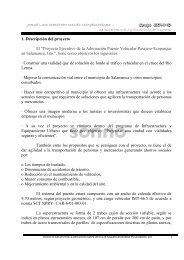plan estratégico para el drenaje pluvial del sur de ... - sinat - Semarnat
plan estratégico para el drenaje pluvial del sur de ... - sinat - Semarnat
plan estratégico para el drenaje pluvial del sur de ... - sinat - Semarnat
Create successful ePaper yourself
Turn your PDF publications into a flip-book with our unique Google optimized e-Paper software.
Vegetación Halófila<br />
MANIFESTACIÓN DE IMPACTO AMBIENTAL MODALIDAD PARTICULAR SECTOR HIDRÁULICO<br />
PROYECTO. PLAN ESTRATÉGICO PARA EL DRENAJE PLUVIAL DEL SUR DE TAMAULIPAS:<br />
OBRAS DE DRENAJE PLUVIAL EN LA DIVISORIA TAMPICO-ALTAMIRA, EN ALTAMIRA, TAM.<br />
OBRAS PARA EL DRENAJE PLUVIAL EN LA CALLE ALDAMA EN CD MADERO Y TAMPICO, TAM.<br />
AMPLIACIÓN DEL DREN DE LA COL. MORELOS Y CONSTRUCCIÓN DE DRENES EN LA ZONA CENTRO, CALLE<br />
ESPERANZA, BENITO JUÁREZ, COLÓN, Y PERIMETRAL FIDEL VELÁZQUEZ, EN TAMPICO, TAM.<br />
INSTITUTO METROPOLITANO DE PLANEACIÓN DEL SUR DE TAMAULIPAS<br />
Este tipo <strong>de</strong> vegetación está adaptada <strong>para</strong> crecer en su<strong>el</strong>os salinos. Usualmente<br />
encontramos vegetación halófila en zonas inundables, así como en los alre<strong>de</strong>dores<br />
<strong>de</strong> las lagunas costeras, <strong>de</strong>ntro d<strong>el</strong> SA cubren las llanuras <strong>de</strong> las lagunas costeras<br />
que antes se encontraban inundadas.<br />
Entre esta vegetación <strong>de</strong>scrita po<strong>de</strong>mos encontrar especies como <strong>el</strong> saladillo<br />
(Atriplex acanthocarpa), <strong>el</strong> vidrillo (Batis marítima), <strong>el</strong> girasol salado (Borrichia<br />
frutescens), <strong>el</strong> crotón d<strong>el</strong> golfo (Croton punctatus), los zacates salados (Distichlis<br />
spicata) y (Eragrostis obtusifolia), espárrago <strong>de</strong> mar (Salicornia ambigua) y Suaeda<br />
nigra.<br />
Mangle<br />
El mangle es <strong>el</strong> único árbol que se <strong>de</strong>sarrolla en un medio marino. Exclusivo <strong>de</strong> un<br />
medio tropical, <strong>el</strong> <strong>de</strong>sarrollo <strong>de</strong> esta especie está íntimamente ligado a los cambios<br />
<strong>de</strong> salinidad y temperatura <strong>de</strong> las aguas por efecto <strong>de</strong> las mareas. De fácil<br />
adaptación, <strong>el</strong> mangle resiste salinida<strong>de</strong>s hasta <strong>de</strong> 40 mil ó 50 mil partes por millón y<br />
también se adapta a aguas dulces con baja concentración salina, aunque en estos su<br />
reproducción se ve disminuida.<br />
La enorme riqueza <strong>de</strong> esta especie es poco conocida, pues permanece custodiada<br />
por un medio inclemente que compren<strong>de</strong> un complicado ecosistema don<strong>de</strong> se<br />
localizan las más diversas formas <strong>de</strong> vida animal y vegetal. El mangle encierra una<br />
trama completa <strong>de</strong> ca<strong>de</strong>nas <strong>de</strong> alimentación que comienza <strong>de</strong>s<strong>de</strong> sus hojas y pue<strong>de</strong><br />
culminar en un pez d<strong>el</strong> tipo <strong>de</strong> los sábalos <strong>de</strong> 200 kilos. Un dato importante es que<br />
mediante la misma protección que <strong>el</strong> mangle proporciona, diversas especies en su<br />
etapa larvaria y juvenil habitan entre sus raíces, <strong>el</strong> camarón es una <strong>de</strong> <strong>el</strong>las por lo<br />
CAPÍTULO IV | Pág. 34


